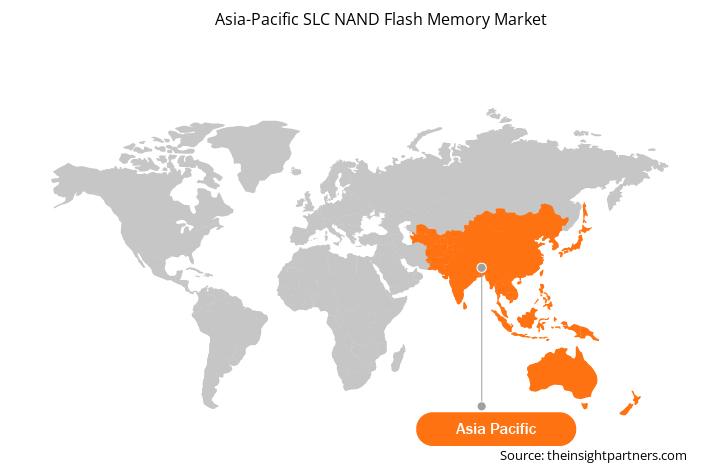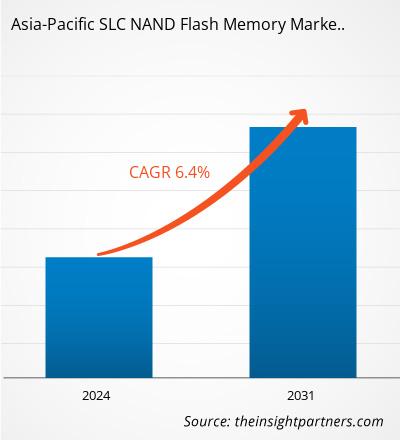アジア太平洋地域の SLC NAND フラッシュメモリ市場規模は、2023 年の 36 億 9,000 万米ドルから 2031 年には 60 億 8,000 万米ドルに達すると予測されています。市場は 2023 年から 2031 年にかけて 6.4% の CAGR を記録すると予測されています。4D NAND テクノロジの出現により、今後数年間で市場にトレンドがもたらされる可能性があります。
アジア太平洋地域のSLC NANDフラッシュメモリ市場分析
民生用電子機器の採用の増加、IoT デバイスの普及率の上昇、通信プロトコルの高速化は、アジア太平洋地域の SLC NAND フラッシュ メモリ市場におけるいくつかの推進要因です。さらに、自律走行車の登場と電子機器の小型化により、予測期間中にアジア太平洋地域の SLC NAND フラッシュ メモリ市場の成長の機会が生まれると予想されます。
アジア太平洋地域のSLC NANDフラッシュメモリ市場の概要
NAND フラッシュ メモリは不揮発性で、電源を切ってもデータを保存します。このため、NAND は内部、外部、ポータブル デバイスに最適です。NAND にはいくつかの種類があります。シングル レベル セル (SLC) NAND は、100,000 回のプログラム/消去サイクル (P/E サイクル) で最高のパフォーマンスと最高の耐久性を提供します。SLC NAND はセルごとに 1 ビットの情報のみを保存します。セルには 0 または 1 のいずれかを保存します。その結果、データの書き込みと取得が高速になり、他の種類の NAND よりも長持ちします。さらに、SLC NAND は耐久性が高いため、信頼性が高く長持ちする供給を必要とする幅広い消費者向けおよび産業用アプリケーションに最適です。モノのインターネット (IoT) デバイス、自動車、ネットワーク機器、セットトップ ボックス、DSL およびケーブル モデム、デジタル テレビ、携帯電話、プリンター、その他の産業用製品に SLC NAND フラッシュ メモリが搭載されています。 SLC NAND フラッシュ メモリは信頼性が高いため、産業オートメーション、医療機器、航空システムなど、高性能とデータ整合性を必要とする企業で使用されています。SLC NAND フラッシュ メモリの主な利点としては、消去およびプログラム サイクルの寿命が最も長いこと、読み取りおよび書き込み速度が速いこと、読み取り/書き込みエラーの可能性が低いことが挙げられます。
要件に合わせてレポートをカスタマイズする
このレポートの一部、国レベルの分析、Excelデータパックなど、あらゆるレポートを無料でカスタマイズできます。また、スタートアップや大学向けのお得なオファーや割引もご利用いただけます。
- このレポートの主要な市場動向を入手してください。この無料サンプルには、市場動向から見積もりや予測に至るまでのデータ分析が含まれます。
アジア太平洋地域のSLC NANDフラッシュメモリ市場の推進要因と機会
消費者向け電子機器の採用増加が市場を有利にする
アジア太平洋地域では、消費者向け電子機器の採用が急増しています。国際貿易局(ITA)の東南アジア地域eコマース予測2020〜2027によると、消費者向け電子機器は引き続き、この地域のeコマース収益の急成長を牽引しています。世界経済フォーラムによると、2023年1月時点で、インドのスマートフォンユーザーは7億人を超え、そのうち4億2,500万人が農村部に住んでいます。この地域の人口の50%以上がスマートフォンを使用しており、アクティブなインターネットユーザーの数は2019年以降45%増加しており、インドの農村部は世界のスマート革命の最前線に立っています。国際貿易局(ITA)によると、ウェアラブルヘルスケア機器(スマートウォッチなど)を含むヘルスケアITの市場は、2025年までに160億に達すると予想されています。
アジア太平洋地域で家電製品の需要を押し上げている主な要因としては、消費者の可処分所得の増加、技術の進歩、デジタル接続のニーズの高まりなどが挙げられます。Trading Economicsによると、インド、中国、日本などの主要国では、2022年と比較して2023年に消費者の可処分所得が増加しました。さらに、この地域の急速な都市化により、家電製品の導入が進みました。India Brand Equity Foundation(IBEF)によると、家電製品分野ではプレミアム化の傾向が加速しており、2024年上半期にはスマートフォン、家電、テレビの売上が大幅に増加しました。
自動運転車の登場
自動車業界は、ユーザーの運転体験を変革するために大きな対策を講じています。ここ数年、電気自動車は環境に優しいことから、政府の支援と相まって消費者を魅了してきました。自動車は、先進運転支援システム(ADAS)、インフォテインメント システム、カー テレマティクスの導入により、よりスマートになり、自己診断機能も向上しており、車内の接続性をさらにサポートしています。現在、アジア太平洋地域では自動運転車の普及率はやや低いですが、今後数年間で加速すると予測されています。特にインドや中国などの発展途上国では、致命的な自動車事故の発生件数の増加により、超インテリジェントな自動運転車の成長が進んでいます。また、コネクテッド カーは、ADAS やその他のコネクテッド カー技術と統合された革新的な安全機能を提供します。次世代のインフォテインメント システムと ADAS はメモリ技術と統合され、より高いパフォーマンスと低消費電力機能を提供します。先進的なコネクテッドカー技術を効果的に実装し機能させるには、メーカーは、変動するデータレートに対応できる柔軟性だけでなく、先進技術をサポートするメモリ技術を必要とします。したがって、自動運転車の登場により、予測期間中にアジア太平洋地域のSLC NANDフラッシュメモリ市場の成長に多くの機会が生まれることが期待されます。
アジア太平洋地域のSLC NANDフラッシュメモリ市場レポートのセグメンテーション分析
アジア太平洋地域の SLC NAND フラッシュ メモリ市場分析の導出に貢献した主要なセグメントは、タイプ、アプリケーション、および密度です。
- タイプに基づいて、アジア太平洋地域のSLC NANDフラッシュメモリ市場は直列と並列に分かれています。2023年には並列セグメントが市場を支配しました。
- 用途別に見ると、アジア太平洋地域のSLC NANDフラッシュメモリ市場は、自動車、産業、通信、コンピューターとIT、民生用電子機器、その他に分類されています。2023年には産業部門が市場で最大のシェアを占めました。
- 密度の面では、アジア太平洋地域の SLC NAND フラッシュメモリ市場は、1GB、2GB、4GB、8GB、8GB 以上に分類されます。2023 年には、8GB 以上のセグメントが市場を支配しました。
アジア太平洋地域におけるSLC NANDフラッシュメモリ市場シェア分析
アジア太平洋地域のSLC NANDフラッシュメモリ市場は、インド、中国、日本、韓国、オーストラリア、その他のアジア太平洋地域に分かれています。収益面では、中国が2023年に最大の市場シェアを占めました。アジア太平洋地域は半導体の製造拠点です。アジア開発銀行によると、東アジアと東南アジアは世界の半導体生産量の80%以上を占めています。この成長は技術の進歩にとって重要であり、世界はこの地域の半導体輸出に依存しています。アジア太平洋地域はSLC NAND技術の輸出国です。また、この地域の経済見通しは世界の半導体需要に依存しています。さらに、SkyHigh Memory Limited、Micron Technology、Inc.、Toshiba Corporationなどの市場プレーヤーの存在が、アジア太平洋地域のSLC NANDフラッシュメモリ市場の成長を支えています。
アジア太平洋地域のSLC NANDフラッシュメモリ市場に関する地域分析
予測期間を通じてアジア太平洋地域の SLC NAND フラッシュ メモリ市場に影響を与える地域的な傾向と要因は、Insight Partners のアナリストによって徹底的に説明されています。このセクションでは、北米、ヨーロッパ、アジア太平洋、中東およびアフリカ、南米および中米にわたるアジア太平洋地域の SLC NAND フラッシュ メモリ市場のセグメントと地理についても説明します。

- アジア太平洋地域のSLC NANDフラッシュメモリ市場の地域別データを入手
アジア太平洋SLC NANDフラッシュメモリ市場レポートの範囲
| レポート属性 | 詳細 |
|---|---|
| 2023年の市場規模 | 36億9000万米ドル |
| 2031年までの市場規模 | 60.8億米ドル |
| 世界のCAGR(2023年~2031年) | 6.4% |
| 履歴データ | 2021-2022 |
| 予測期間 | 2024-2031 |
| 対象セグメント | タイプ別
|
| 対象地域と国 | アジア太平洋
|
| 市場リーダーと主要企業プロフィール |
|
アジア太平洋地域のSLC NANDフラッシュメモリ市場のプレーヤー密度:ビジネスダイナミクスへの影響を理解する
アジア太平洋地域の SLC NAND フラッシュ メモリ市場は、消費者の嗜好の変化、技術の進歩、製品の利点に対する認識の高まりなどの要因により、エンド ユーザーの需要が高まり、急速に成長しています。需要が高まるにつれて、企業は提供品を拡大し、消費者のニーズを満たすために革新し、新たなトレンドを活用し、市場の成長をさらに促進しています。
市場プレーヤー密度とは、特定の市場または業界内で活動している企業または会社の分布を指します。これは、特定の市場スペースに、その市場規模または総市場価値に対してどれだけの競合相手 (市場プレーヤー) が存在するかを示します。
アジア太平洋地域のSLC NANDフラッシュメモリ市場で事業を展開している主要企業は次のとおりです。
- マイクロンテクノロジー株式会社
- キオクシア株式会社
- サムスン電子株式会社
- ウィンボンド・エレクトロニクス
- スカイハイメモリー株式会社
- マクロニクスインターナショナル株式会社
免責事項:上記の企業は、特定の順序でランク付けされていません。

- アジア太平洋地域のSLC NANDフラッシュメモリ市場のトップキープレーヤーの概要を入手
アジア太平洋地域のSLC NANDフラッシュメモリ市場のニュースと最近の動向
アジア太平洋地域の SLC NAND フラッシュ メモリ市場は、主要な企業出版物、協会データ、データベースなどの一次調査と二次調査後の定性的および定量的データを収集して評価されます。アジア太平洋地域の SLC NAND フラッシュ メモリ市場における主要な動向のいくつかを以下に示します。
- メモリソリューションの世界的リーダーであるキオクシア株式会社は、業界をリードする北上工場のFab2(K2)の建屋が7月に完成したと発表しました。K2は、日本の岩手県にある北上工場の2番目のフラッシュメモリ製造施設です。需要が回復しているため、同社はフラッシュメモリ市場の動向を注意深く見守りながら、段階的に設備投資を行っていきます。キオクシアは、2025年秋にK2の稼働を開始する予定です。
(出典:キオクシア株式会社、プレスリリース、2024年8月)
- 先進メモリ技術の世界的リーダーであるサムスン電子は、第8世代垂直NAND(V-NAND)をベースにした業界初のPCIe 4.0車載SSDの開発に成功したと発表しました。業界をリードする速度と強化された信頼性を備えた新しい車載SSD AM9C1は、車載アプリケーションのオンデバイスAI機能に最適なソリューションです。サムスンの5ナノメートル(nm)コントローラをベースに構築され、シングルレベルセル(SLC)Namespace2機能を提供するAM9C1は、大量のデータを含むファイルへのアクセスを容易にする高いパフォーマンスを発揮します。
(出典:サムスン電子株式会社、プレスリリース、2024年9月)
アジア太平洋地域のSLC NANDフラッシュメモリ市場レポートの対象範囲と成果物
「アジア太平洋地域のSLC NANDフラッシュメモリ市場の規模と予測(2021〜2031年)」では、以下の分野をカバーする市場の詳細な分析を提供しています。
- アジア太平洋地域のSLC NANDフラッシュメモリ市場規模と予測(対象範囲に含まれるすべての主要市場セグメントの地域および国レベル)
- アジア太平洋地域のSLC NANDフラッシュメモリ市場の動向と、推進要因、制約、主要な機会などの市場動向
- 詳細なPESTおよびSWOT分析
- アジア太平洋地域のSLC NANDフラッシュメモリ市場分析。主要な市場動向、地域の枠組み、主要プレーヤー、規制、最近の市場動向を網羅しています。
- アジア太平洋地域のSLC NANDフラッシュメモリ市場の市場集中、ヒートマップ分析、主要プレーヤー、最近の動向を網羅した業界展望と競争分析
- 詳細な企業プロフィール
- 過去2年間の分析、基準年、CAGRによる予測(7年間)
- PEST分析とSWOT分析
- 市場規模価値/数量 - 世界、地域、国
- 業界と競争環境
- Excel データセット
最新レポート
お客様の声
購入理由
- 情報に基づいた意思決定
- 市場動向の理解
- 競合分析
- 顧客インサイト
- 市場予測
- リスク軽減
- 戦略計画
- 投資の正当性
- 新興市場の特定
- マーケティング戦略の強化
- 業務効率の向上
- 規制動向への対応























 無料サンプルを入手 - アジア太平洋地域のSLC NANDフラッシュメモリ市場
無料サンプルを入手 - アジア太平洋地域のSLC NANDフラッシュメモリ市場